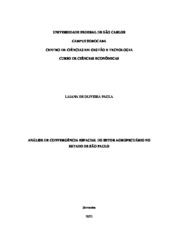| dc.contributor.author | Paula, Laiana de Oliveira | |
| dc.date.accessioned | 2022-10-06T20:46:46Z | |
| dc.date.available | 2022-10-06T20:46:46Z | |
| dc.date.issued | 2022-09-22 | |
| dc.identifier.citation | PAULA, Laiana de Oliveira. Análise de convergência espacial do setor agropecuário no estado de São Paulo. 2022. Trabalho de Conclusão de Curso (Graduação em Ciências Econômicas) – Universidade Federal de São Carlos, Sorocaba, 2022. Disponível em: https://repositorio.ufscar.br/handle/ufscar/16820. | * |
| dc.identifier.uri | https://repositorio.ufscar.br/handle/ufscar/16820 | |
| dc.description.abstract | According to the Institute of Agricultural Economics, the agricultural sector is the main activity in 260 municipalities in São Paulo (BEZERRA et al, 2005). This work aims to identify whether the disparity in the value added of the agricultural sector decreased between 2002 and 2019 in the municipalities of the state of São Paulo. Initially, Exploratory Spatial Data Analysis (AEDE) is used, based on Moran's I statistic to show patterns of spatial association, and through the local indicator of spatial association (LISA) with the identification of clusters. Finally, the regression of β-convergence was carried out in order to identify whether the values are converging on the average, that is, if the municipalities with the lowest value added per capita in the agricultural sector show greater growth in relation to the municipalities with the highest value. added per capita of the agricultural sector, as identified in the β-convergence studies present in the literature. As a result, the work observes, through Moran's I, the presence of a positive spatial association of the agricultural sector between the municipalities. The Moran Local (LISA) statistic showed the incidence of three clusters of HH group (high value of the agricultural sector with similar neighbors) and one LL group (municipalities with low value of the agricultural sector with similar neighbors). In the end, the absolute β-convergence regression indicates a negative value of the β coefficient, demonstrating that the higher the initial agricultural value added, the lower the growth of value added in the agricultural sector in the study period. | eng |
| dc.description.sponsorship | Não recebi financiamento | por |
| dc.language.iso | por | por |
| dc.publisher | Universidade Federal de São Carlos | por |
| dc.rights | Attribution-NonCommercial-NoDerivs 3.0 Brazil | * |
| dc.rights.uri | http://creativecommons.org/licenses/by-nc-nd/3.0/br/ | * |
| dc.subject | Convergência-β | por |
| dc.subject | Setor agropecuário | por |
| dc.subject | Análise exploratória de dados espaciais | por |
| dc.subject | β-convergence | eng |
| dc.subject | Agricultural sector | eng |
| dc.subject | Exploratory analysis of spatial data | eng |
| dc.title | Análise de convergência espacial do setor agropecuário no estado de São Paulo | por |
| dc.title.alternative | Analysis of spatial convergence of the agricultural sector in the state of São Paulo | eng |
| dc.type | TCC | por |
| dc.contributor.advisor1 | Gomes, Alexandre Lopes | |
| dc.contributor.advisor1Lattes | http://lattes.cnpq.br/5002157193962189 | por |
| dc.description.resumo | De acordo com o Instituto de Economia Agrícola o setor agropecuário é a atividade principal em 260 municípios paulistas (BEZERRA et al, 2005). Este trabalho tem como objetivo identificar se a disparidade do valor adicionado do setor agropecuário diminuiu entre 2002 e 2019 nos municípios do estado de São Paulo. Inicialmente, utiliza-se da Análise Exploratória de Dados Espaciais (AEDE), a partir da estatística I de Moran para evidenciar padrões de associação espacial, e por meio do indicador local de associação espacial (LISA) para a identificação de clusters. Por fim, efetuou-se a regressão da convergência-β com o intuito de identificar se os valores estão convergindo a média, ou seja, se os municípios com menor valor adicionado per capita do setor agropecuário apresentam maior crescimento em relação aos municípios com maior valor adicionado per capita do setor agropecuário, conforme identificado nos estudos de convergência-β presentes na literatura. Como resultados, o trabalho observa por meio do I de Moran, a presença de associação espacial positiva do setor agropecuário entre os municípios. Por meio da estatística Moran Local (LISA) evidenciou-se a incidência de três agrupamentos de clusters HH (alto valor do setor agropecuário com vizinhos similares) e um agrupamento LL (municípios com baixo valor do setor agropecuário com vizinhos similares). Ao final, a regressão da convergência-β absoluta indica um valor negativo do coeficiente β, demonstrando que quanto maior o valor adicionado agropecuário inicial, menor o crescimento do valor adicionado do setor agropecuário no período de estudo. | por |
| dc.publisher.initials | UFSCar | por |
| dc.subject.cnpq | CIENCIAS SOCIAIS APLICADAS::ECONOMIA::ECONOMIA REGIONAL E URBANA | por |
| dc.publisher.address | Câmpus Sorocaba | por |
| dc.contributor.authorlattes | http://lattes.cnpq.br/3317487795443157 | por |
| dc.publisher.course | Ciências Econômicas - CEc-So | por |

